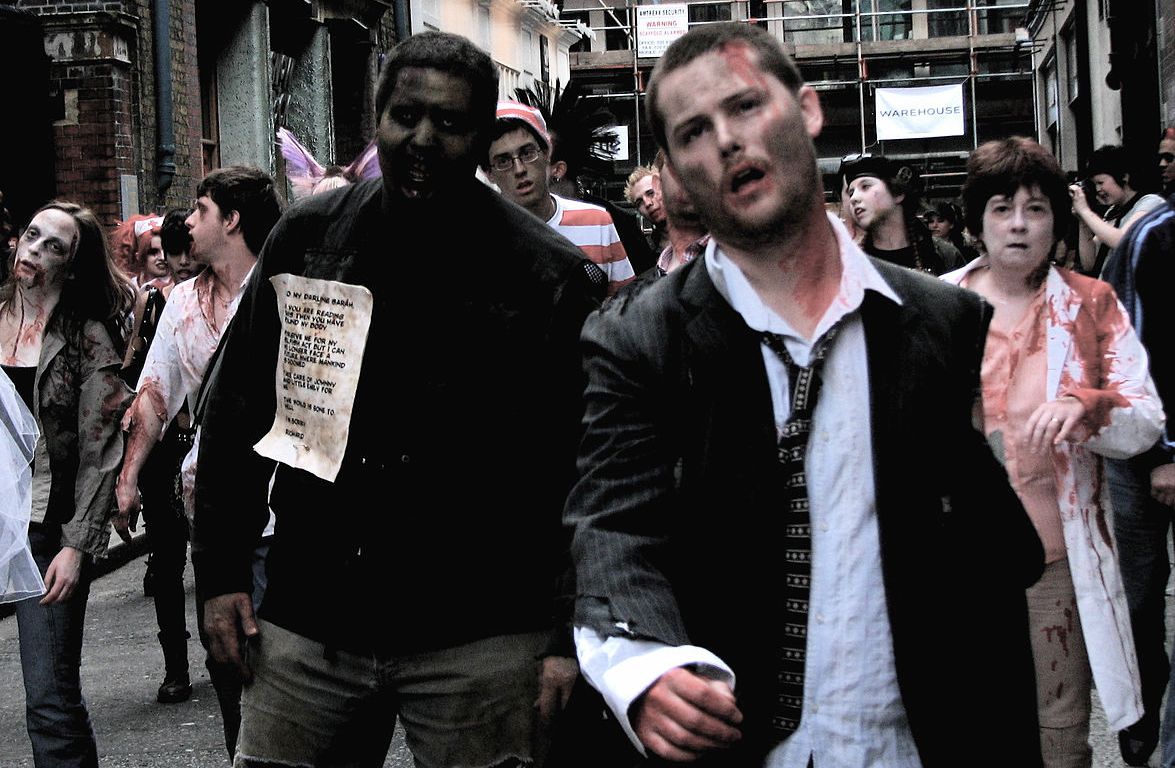For this Halloween, CPJ is bringing back a spooky article from 2017 on the value of zombie preparedness.
Zombies have become a fixture in literary and cinematic culture over the past century. The list of on-screen zombie productions is extensive, ranging from White Zombie in 1932 and Night of the Living Dead in 1968, to this year’s Patient Z and dozens of others in between. In 2016, Netflix boasted a buffet of 19 zombie-themed shows to satiate their viewers’ appetite for the undead. Yet over the past decade, zombies have broken free of their cinematic chains. Runners can now have their zombie fix on-the-go, with zombie-themed races in which costumed zombies chase runners, or via zombie running apps. For the extreme among us, there are even zombie survival camps: “the ultimate weekend apocalypse adventure.”
The cultural capital of zombies has not gone unnoticed. Since 2011, the threat of a zombie outbreak has been used in a more unexpected way: as a communication strategy for emergency preparedness. In response to low engagement in previous emergency preparedness campaigns, in May 2011, the Centers for Disease Control and Prevention (CDC) opted for a creative thematic pivot in their preparedness communication. And so, Preparedness 101: Zombie Apocalypse was born. This campaign first manifested as a humorous blog post detailing key steps to take in the event of a zombie apocalypse,1 such as building an emergency kit and developing a family emergency plan.2 The CDC’s goals for this campaign were to widen the reach of emergency preparedness awareness materials and draw in younger audiences.
A quick glance at the post’s engagement metrics renders their strategy an unequivocal success; the post received unparalleled traffic, crashing the blog platform within nine minutes of the tweet directing viewers to the blog. The campaign was covered extensively by media outlets for more than a year following the original blog post. By 2013, two years after the original posting date, the post had garnered approximately 1,332% more views than average posts on the CDC Public Health Matters Blog, and 1,233 comments, compared to the average of five comments. The CDC’s social media followers across various platforms also grew significantly in response.3 Moreover, the immense popularity of the post led the CDC to develop a host of Zombie Preparedness materials, including a dedicated blog, posters, lesson plans for teachers, and even a graphic novella.
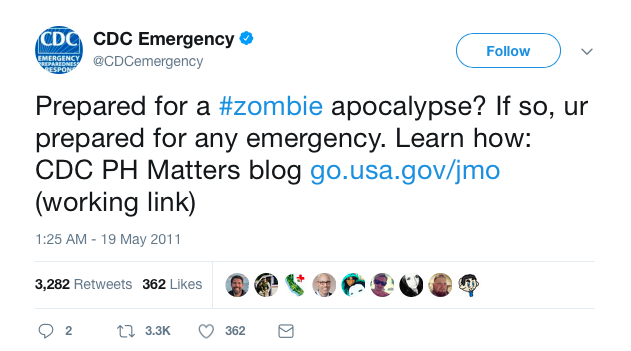
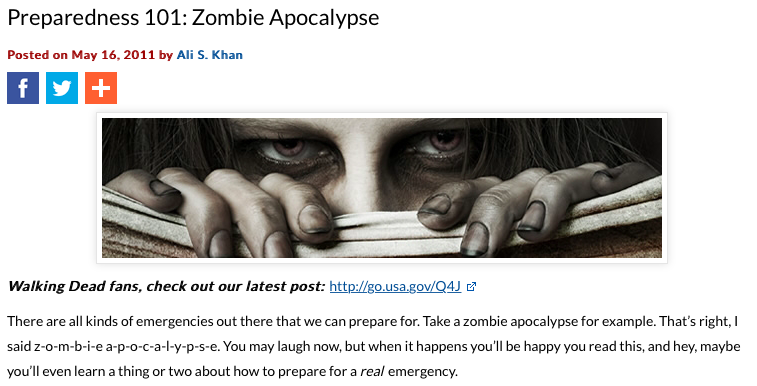
Since 2011, other organizations in cities across the country have followed the CDC’s creative lead, and further capitalized on the Halloween season to launch preparedness education and trainings with a zombie theme. For example, REI offers a Zombie Preparedness – Surviving a Zombie Apocalypse workshop, which covers important survival strategies adequate for any disaster. From Zombie Scavenger Hunts in Anchorage, Alaska (2012) to Zombie Artwalks in Abilene, Texas (this month), zombie preparedness has consistently captivated geographically diverse audiences and has catalyzed unique partnerships around emergency preparedness.
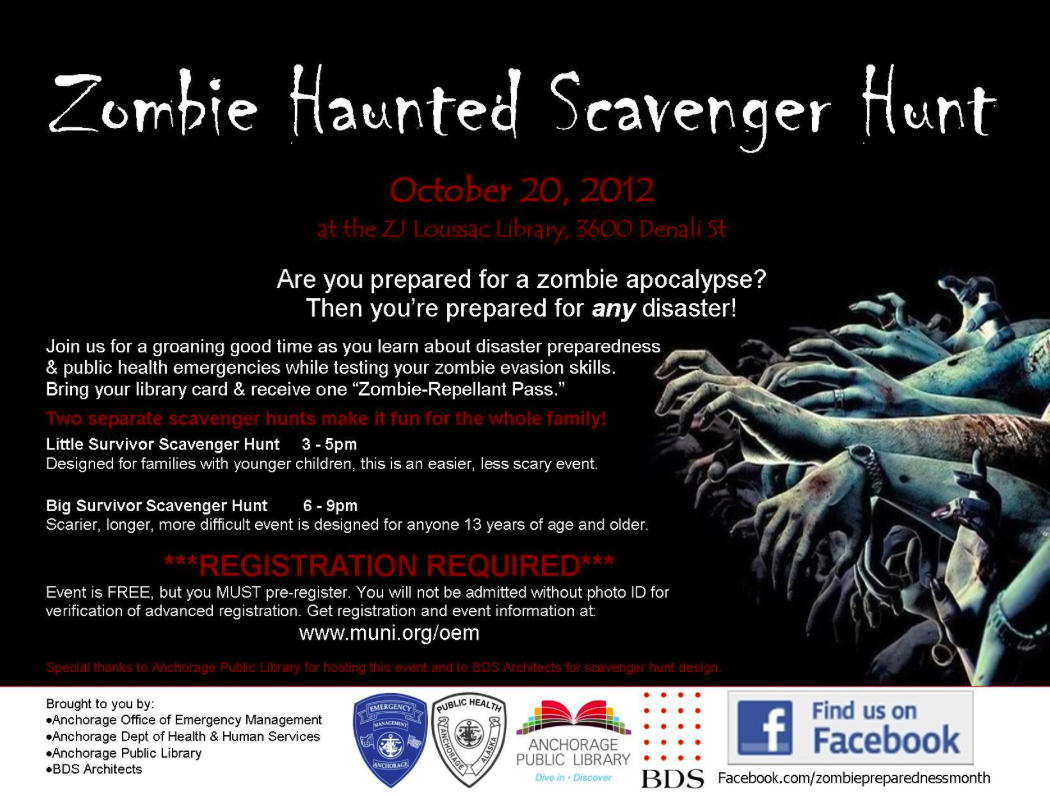
Perhaps more interesting, however, is the adoption of zombie preparedness at the state level. Each October since 2014, Governor of Kansas Sam Brownback signs a proclamation declaring October “Zombie Preparedness Month.” This tradition, spearheaded by the Kansas Division of Emergency Management echoes the sentiment of the CDC’s campaign, insisting that “if you’re prepared for zombies, you’re prepared for anything.”4 Furthermore, in February of 2017, the state House of Illinois passed House Resolution 0030 declaring October “Zombie Preparedness Month.” This law “urges all Illinoisans to educate themselves about natural disasters and take steps to create a stockpile of food, water, and other emergency supplies that can last up to 72 hours.”5
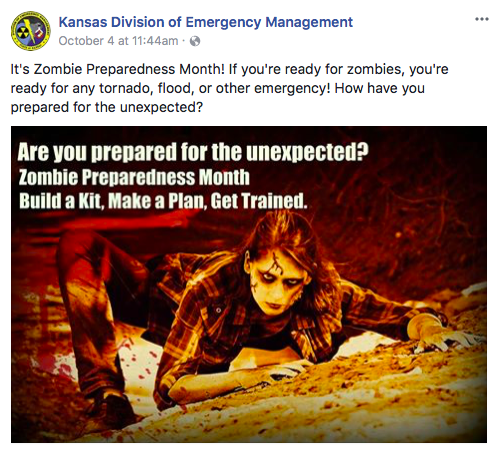
Although the CDC’s novel campaign has certainly been effective in garnering significant attention and replication across the country, measuring the extent to which this messaging campaign led to increased actual emergency preparedness actions is more difficult to quantify. A 2015 study conducted by PhD students at the School of Communication at Loyola University Chicago investigated this question by administering an online survey about emergency preparedness to two groups of undergraduates: one previously exposed to Preparedness 101 Zombie Apocalypse, and the other exposed to CDC’s traditional preparedness messaging campaigns. Their findings indicate that the zombie material did not have significant impacts on their performance on the preparedness survey compared to the traditional messaging group.6
Even with these results, there is clear value in zombie preparedness, beyond the laughs. According to a national survey conducted in 2016 by the National Center for Disaster Preparedness at Columbia University, almost two-thirds of US households lack sufficient emergency plans. More than 30% of US households with kids are unaware of their school evacuation plans, and over 40% lack understanding about their child’s evacuation location in the case of an emergency.7 Zombie preparedness can only help this, especially due to its potential for youth education. Additionally, true to both their nature and their historical staying power in popular culture, zombies aren’t likely to go away anytime soon. Bundling zombies with preparedness education every October is nothing but good (and perhaps spooky) news for emergency preparedness – planners, public health advocates, and hazard mitigation experts take note.
1 FEMA. 2012. “Zombie Preparedness: Effective Practices in Promoting Disaster Preparedness,” Webinar Transcript. https://www.fema.gov/media-library-data/20130726-1913-25045-3339/20130430_final_zombie_preparedness_transcript.pdf
2 Khan, Ali S. 2011.“Preparedness 101: Zombie Apocalypse,” CDC Public Health Matters Blog, May 11. https://blogs.cdc.gov/publichealthmatters/2011/05/preparedness-101-zombie-apocalypse/
3 Kruvand, Marjorie and Maggie Silver. 2013. “Zombies Gone Viral: How a Fictional Zombie Invasion Helped CDC Promote Emergency Preparedness” Case Studies in Strategic Communication. http://cssc.uscannenberg.org/wp-content/uploads/2013/10/v2art3.pdf
4 Barber, Elizabeth. 2014. “Kansas Will be Prepared for the Zombie Apocalypse.” Time, September 24. http://time.com/3424392/kansas-zombie-preparedness-month-sam-brownback-natural-disasters/
5 Illinois General Assembly. 2017. “Bill Status of HR0030.” http://www.ilga.gov/legislation/BillStatus.asp?DocTypeID=HR&DocNum=30&GAID=14&SessionID=91&LegID=99787
6 Kruvand, M and FB Bryant. 2015. “Zombie Apocalypse: Can the Undead Teach the Living How to Survive an Emergency?” Public Health Reports. https://www.ncbi.nlm.nih.gov/pubmed/26556937
7 National Center for Disaster Preparedness at Columbia University’s Earth Institute. 2016. “Children in Disasters: Do Americans Feel Prepared? A National Survey.” National Center on Disaster Preparedness Research Briefs. https://academiccommons.columbia.edu/catalog/ac:194073
Featured image: A zombie flashmob (fleshmob) takes on London in 2007. Photo Credit: CGP Grey via Wikimedia Commons, CC BY 2.0.
About the Author: Margaret Keener is a first year master’s student in the Department of City and Regional Planning, focusing on land use and environmental planning. She is particularly interested in resilience and climate change adaptation. Prior to UNC, Margaret worked as a graphic designer for ICLEI – Local Governments for Sustainability. Outside of class, Margaret enjoys listening to podcasts while running, playing outdoor team sports, and exploring new places on foot.

